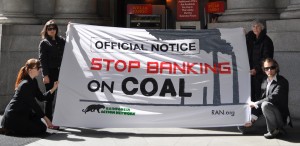 Last week, Bank of America released its 2010 Corporate Social Responsibility Report. It is more accurately described as “Bank of America’s 2010 Shirking Responsibility Report,” however.
Last week, Bank of America released its 2010 Corporate Social Responsibility Report. It is more accurately described as “Bank of America’s 2010 Shirking Responsibility Report,” however.
The document, titled “Opportunity in Motion,” is 87 pages of information about how the company conducts global business and holds itself accountable to “customers, employees, shareholders and communities,” according to an introduction from BoA CEO Brian T. Moynihan.
The section addressing Bank of America’s environmental policies is toward the end of the report and breaks into two sections: “Financing a Low Carbon Economy” and “Operations.” While banks absolutely should promote energy efficiency, recycling and green-building in their operations, RAN is much more interested in the investments that banks make (or don’t make) in environmentally impactful industries — so we took a close look at how, exactly, Bank of America says it is financing a low carbon economy.
The chapter opens with a quote, “[We] have consistently operated from the firm conviction that business and environmental objectives go hand in hand.” It’s great that Bank of America acknowledges its responsibility to environmental concerns. The company goes on to promote its much-publicized Environmental Business Initiative, which was started in 2007 and commits BoA to spending $20 billion over 10 years to address “climate change through our lending, investing, products and services, and enhancing the efficiency of our own operations.” As of 2010 BoA has spent $11.6 billion of that $20 billion in a series of investments that are not specifically listed in the report and don’t appear to be on the company’s website either.
This lack of transparency makes it hard to thoroughly analyze Bank of America’s Environmental Business Initiative investments. Instead, we’re left to wonder what, exactly, BoA means by “innovative companies addressing climate change issues” when it describes its “Strategic Environmental Investments.” Or how, exactly, Bank of America “invests in transactions that finance emission reductions in the global carbon markets.”
Bank of America goes on to state that it has “increased our investments in and financing of advanced energy technologies to encourage the growth and development of cleaner renewables and other low-carbon energy such as solar, wind, biomass and biofuel.” They provide examples of investments in wind and solar energy. To test this assertion I looked up Bank of America’s investments in alternative energy in RAN’s Bloomberg database. It would appear that in 2010 Bank of America invested over $590 million in alternative energy. But a closer look shows that the money was invested in 5 companies, one of which is a “clean” coal company, one biomass, two natural gas and only one solar company. This research indicates to me that Bank of America’s “other low-carbon energy” investments could mostly be investments in false solutions rather than true clean, green, renewable energy sources.
At the end of the chapter, Bank of America includes two short paragraphs to describe its coal policy. Part of the statement reads, “Our coal policy is focused on advancing technologies, including carbon capture and storage, supporting best practices in managing the environmental impacts attributed to coal and addressing the surface mining of coal, in particular in eastern Appalachia in the U.S.” This statement is unimpressive for a number of reasons.
First, I suspect that Bank of America means central Appalachia and not eastern Appalachia — a minor but telling mistake.
Second, instead of committing to financing less coal, the company describes investments in “clean” coal and mediating the impacts of the coal industry. This is unsurprising, since Bank of America is the #1 bank invested in the coal industry, according to Bloomberg. In 2010 BoA invested $3.9 billion in coal companies — compared to the aforementioned $590 million in “renewables and other low-carbon energy,” such as it was. If Bank of America invested this money in its Environmental Business Initiative instead, imagine how quickly they would reach their goal of $20 billion for the environment!
Third, Bank of America is trying to spin its role in bankrolling the devastatingly destructive coal industry as environmentally responsible. Shame on Bank of America.
If Bank of America wants to position itself as an environmentally responsible corporate citizen, the company has a lot of work to do. It has a long way to go before BoA can transparently demonstrate a shift away from investment in dirty fossil fuels and toward renewable energy sources. I look forward to Bank of America becoming a true financier of low-carbon energy.